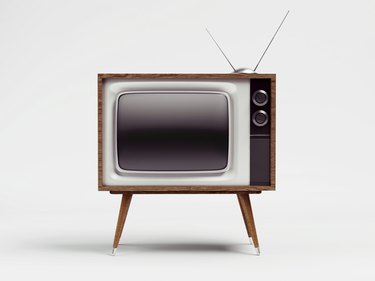
In its most simplest terms, a television is a device that can receive a signal through over-the-air transmissions, then use the information in the signal to recreate and display an image and reproduce sound. While those basics haven't changed over the years, the technology used to create the display has evolved. This has allowed a dramatic narrowing of the set behind the screen, in turn, making larger screens physically and financially viable.
Tuner and Inputs
Video of the Day
Virtually every television contains a tuner; those that don't are usually referred to as a "display" instead. The tuner is similar to that in a radio in that it receives information transmitted over the airwaves, but it uses the information to recreate both sounds and images. The tuner allows the TV to identify the signal relating to a specific station. Today televisions also have a range of video and audio input sockets that allow them to get information from devices, such as cable and satellite boxes, video players (including DVD and Blu-ray) and gaming consoles. These inputs don't require tuners, as each input only carries one set of audio/video information at a time.
Video of the Day
Display: Cathode Ray
Older televisions use a cathode ray system to display an image. This involves a "gun" that shoots electron beams in a moving pattern following rows across the screen from top to bottom. An electrical signal generated by the television from the video signal controls how strong the electron beam is at any precise moment. In turn, this decides whether or not a tiny dot on the screen is illuminated as the beam passes. This system replicates an image on the screen, which happens so quickly that the viewer sees it as a continuous stream of complete images, making moving video. To replicate color, the dots are arranged in a pattern of red, green and blue. They are close enough together that illuminating these dots in varying combinations gives the appearance of different colours.
Display: Flat Screen
The big disadvantage of the cathode ray system is that it needs a large space over which to direct the electrons to the screen, resulting in a device that is very deep from front to back. Newer televisions use the same basic procedure of breaking an image into dots and then recreating it on the screen, but use alternative technologies to allow for a flatter screen. Plasma screens replace the dots with sets of three tiny fluorescent lights, again red, green and blue. These lights contain plasma gas, which lights up when an electrical charge is applied. LCD screens beam light through a panel of liquid crystals that either let light through or block it, depending on their electrical charge. LED screens use the same technology as LCD screens, but use LEDs rather than a large bulb to provide the light beam; this allows thinner screens with greater contrast between dark and light.
Audio Signal
The basics of television audio are the same as it is with other audio equipment: the set can receive audio information along with the video information from a particular over-the-air channel via the tuner, or it can receive it through the other inputs. As with most audio information, the set uses one or more loudspeakers which combine an electrical signal with two magnets to create vibrations in a cone, creating sound waves. The big difference is that the loudspeakers have a heavy magnetic shielding to prevent the magnets from interfering with the picture display system. This shielding can mean TV sets have relatively low powered speakers, which is one reason some people prefer to use external speaker systems or sound bars.